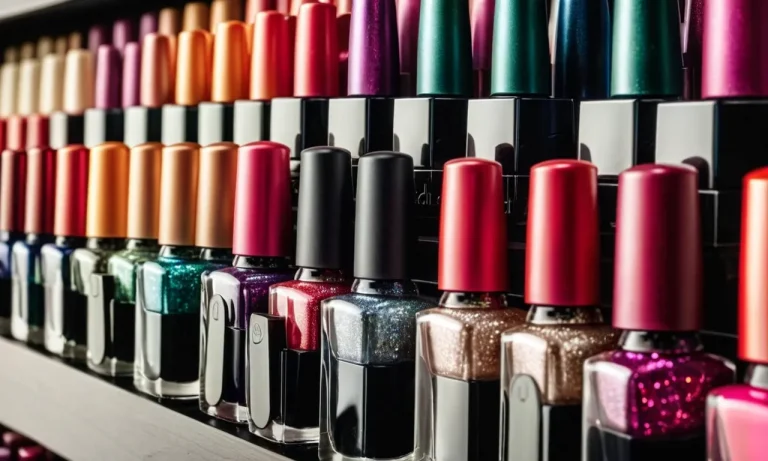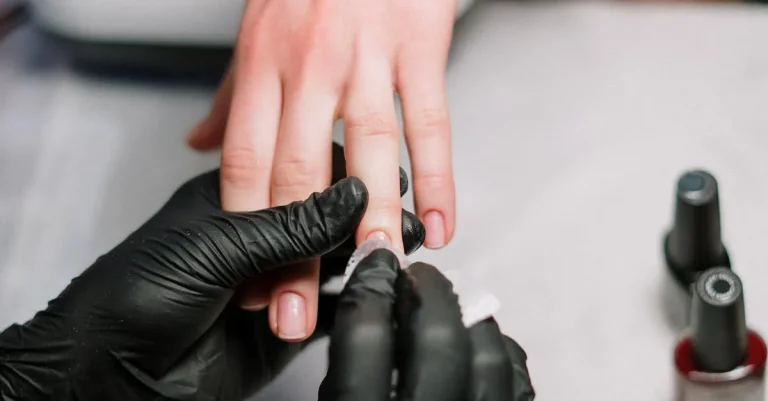How To Remove Nail Polish From Leather: A Step-By-Step Guide
Oh no, you’ve accidentally gotten nail polish on your leather couch or jacket! Don’t panic – removing nail polish from leather is possible with the right techniques. In this comprehensive guide, you’ll learn foolproof methods to lift even the most stubborn polish off leather safely and effectively.
If you’re short on time, here’s a quick answer to your question: use non-acetone nail polish remover and blot gently to lift the polish. Then follow up with a leather conditioner.
Read on as we walk through step-by-step instructions, explain why certain removal methods work better than others, and provide tips to avoid damage and keep your leather looking pristine. With a little care and the right products, you can erase any traces of nail polish from leather.
So take a deep breath – you’ve got this!
Assess the Type and Location of the Stain
Determine if the polish is wet or dry
The first step in removing nail polish from leather is to determine if the stain is wet or dry. This will dictate your approach. If the polish spilled recently and is still wet, you’ll want to act quickly before it dries and sets into the leather.
Scrape off any excess wet polish gently with a dull knife or spoon. Avoid rubbing, as this could push the stain further into the leather. If the stain is already dry, proceed with caution when attempting to loosen and lift it.
Consider the leather type and color
The technique you use to remove dried polish may depend on the type and color of the leather. On finished leathers with protective coatings like patent leather, lacquered leather or bonded leather, you’ll need to be very gentle.
These leathers can scratch, crack or peel if you use harsh chemicals or too much friction. Unfinished leathers like suede and nubuck are also delicate and require special care. Light colored leathers may show more obvious staining, while textured leathers like pebbled grain may hide stains better.
Evaluate the leather characteristics to determine the safest approach.
Check if the stain has spread or penetrated
Inspect the stain to see if the nail polish has spread out across the surface of the leather or if it has soaked deeper into the pores. Surface stains are easier to treat. But if the polish has penetrated into the leather, it will take more effort to lift it out from within the layers.
Try to determine how stubborn the stain will be so you can use the appropriate level of cleaning agents and techniques. Set realistic expectations for stain removal based on the depth of the penetration.
By considering the age and nature of the nail polish stain and the characteristics of the leather, you can determine the best way to tackle the removal process. Careful inspection now prevents damage later.
Act Fast on Wet Polish
Blot gently with paper towels
If you’ve just spilled nail polish on your leather item, it’s important to act quickly before the polish has a chance to dry and adhere to the leather. The first step is to gently blot the wet polish with a paper towel or cloth to soak up as much of the liquid as possible.
Avoid rubbing vigorously at this stage, as that could drive the polish deeper into the leather’s porous surface.
Use non-acetone nail polish remover
After blotting up excess polish, grab a non-acetone nail polish remover. Acetone-based removers can be too harsh for delicate leathers. Gently dab some non-acetone remover onto a clean cloth and work it into the stained area of the leather.
Allow it to sit for 1-2 minutes to dissolve the remaining traces of polish. Then, blot the area with a fresh paper towel.
Avoid abrasive rubbing
It’s important not to abrasively rub the leather as you attempt to remove the nail polish, as rubbing can damage the item’s surface. Instead, continue dabbing more remover and blotting until no more traces of color transfer onto the cloth.
This may take multiple applications and some patience, but rubbing or scrubbing aggressively can wreck the leather’s finish.
If these DIY steps aren’t fully effective after several tries, it’s best to take the item to a professional leather cleaner. Specialty leather cleaners have commercial-grade solvents that can break down stubborn polish stains without damaging the leather itself.
Tackle Dry Stains Gently
Apply nail polish remover and let it sit
When dealing with dry nail polish stains on leather, it’s important to take a gentle approach. Start by applying a small amount of nail polish remover containing acetone directly onto the stained area using a cotton ball or pad. Ensure the remover fully saturates the stain.
Then, let it sit for 1-2 minutes to allow the acetone to break down the hardened nail polish.
As you wait, the nail polish remover will begin dissolving the stain without having to scrub aggressively. This helps prevent potential damage to the leather surface. Just be patient and give the acetone-based solution time to work its magic!
Gently blot the area with a cloth
Once the nail polish remover has had a chance to penetrate the stain, the next step is to gently blot the area. Use a clean lint-free cloth like a microfiber towel or even better, a suede cloth designed specifically for delicates.
Carefully press down and lift straight up to absorb excess moisture and start lifting the stained particles.
Avoid any twisting or aggressive rubbing motions. Blotting is extremely useful for tackling stains on easily damaged materials like leather. So take a delicate approach and let the cloth do the work as you sequentially blot from the outside of the stain inward.
Use short, light strokes when scrubbing
If some visible stain remains after blotting, some very light scrubbing may be required. Before scrubbing, check on an inconspicuous area of the leather first to ensure it can handle gentle cleaning without damage.
Provided the test area looks OK, use a clean toothbrush or suede brush to gently brush the stained leather in short, light strokes.
Keep the scrubbing extremely mild to avoid harming the leather finish or fibers underneath. Target only the most stubborn remnants of the stain, ceasing scrubbing if no more transfer occurs. According to cleaning experts at The Maids, around 3-5 gentle scrub strokes is typically sufficient for dried nail polish on delicate leathers.
The key is patience and delicacy. Let the nail polish remover and blotting cloth do most of the work to safely lift the dried stain without overly manipulating the leather item. With this gentle process, you can successfully remove dried nail polish from leather goods without causing damage.
Favor Non-Acetone Polish Remover
Acetone can dry out and damage leather
When attempting to remove nail polish from leather, it’s best to avoid using 100% acetone-based nail polish removers. While acetone is an effective solvent, it can be quite harsh and drying on leather material.
The active ingredient acetone is both a solvent and a drying agent. It works quickly to break down the nail polish, but it achieves this by evaporating and absorbing oils and moisture. This can leave leather looking dried out and cracked over time with repeated exposure.
Sites like Leather Repair Kit caution that acetone-based removers can even alter the leather dye and finish, causing discoloration and damage.
Non-acetone removers are gentler on leather
Instead of acetone removers, leather experts recommend using a non-acetone nail polish remover whenever possible. These gentle nail polish removers rely on milder solvents like ethyl acetate or isopropyl alcohol to break down the polish.
While non-acetone removers may take a little longer to dissolve the nail polish, they are far less likely to dry out, discolor or otherwise damage the leather material. This makes them the smarter, safer option for leather surfaces.
Many popular nail polish remover brands like Sally Hansen and CVS Health sell dedicated non-acetone nail polish removers just for delicate surfaces like leather, suede or patent leather.
Test remover on small hidden area first
While non-acetone nail polish removers are designed for use on leather, it never hurts to exercise some extra caution. There can still be variability in leather dye, finish and condition from piece to piece.
Experts thus recommend first testing any nail polish remover on a small, discreet section of leather to check for any unwanted effects:
- Choose an inconspicuous spot like an inside fold or underside.
- Dab on a bit of remover and let it sit for a few seconds.
- Gently wipe away with a clean cloth.
- Inspect for any damage, discoloration, excess drying or changes in texture/finish.
If no issues arise, you can safely apply the remover to tackle the nail polish stain itself. But if you notice any leather alterations, discontinue use. Switch products or explore alternative removal methods instead to avoid lasting damage.
Taking this simple precautionary step first will ensure you keep your treasured leather looking fabulous for years to come!
Condition the Leather After Removal
Moisturize leather to avoid cracks and fading
After removing nail polish from leather, it’s crucial to moisturize the leather to avoid potential cracking or fading over time. Leather tends to dry out without proper conditioning, which can cause it to become brittle and damaged.
A high-quality leather conditioner will provide much-needed moisture and oils back into the leather fibers.
Choose a leather conditioner specifically formulated for the type of leather you’re working with, whether genuine, bonded, suede, or other varieties. Test a small inconspicuous area first to check for potential discoloration before applying it widely.
Use a clean, soft cloth to gently massage the conditioner into the leather until it absorbs fully. Allow it to dry naturally afterwards.
Use leather conditioner or mink oil
Experts often recommend using a dedicated leather conditioner or mink oil to nourish leather after removing stubborn nail polish. Quality leather conditioners contain ingredients like beeswax, coconut oil, lanolin, and other emollients that soak into the leather to soften, protect, and revitalize it.
Follow the product instructions closely and pay attention to the coverage amount and drying times suggested.
Alternatively, some people like using mink oil, which comes from mink fur fat and achieves similar conditioning effects. It can help repel moisture while making the leather more pliable. Apply mink oil sparingly with a clean cloth and wipe away any excess.
Too much mink oil could leave an unpleasant residue behind on the surface of fine leather items.
Buff gently with a soft cloth
Once the leather conditioning product of choice has soaked in fully and any residue wiped away, give the leather item a gentle buff with a clean, dry microfiber cloth or other ultra-soft material. Use light, circular motions to buff away any remaining debris while restoring the leather’s natural sheen.
Just be very careful not to rub too vigorously, as this could scratch or further damage the leather.
Check to ensure no nail polish residue or oil smudges remain after buffing. Target any remaining spots individually with conditioner and a gentle rag until the leather returns to its smooth, supple state. Properly conditioned leather should feel soft and matte rather than sticky, greasy or tacky.
Prevent Future Nail Polish Stains
Accidentally spilling nail polish on leather items like purses, shoes, and furniture can be frustrating. However, you can take some simple precautions to avoid these annoying stains in the future.
Apply Polish Away from Leather Surfaces
When painting your nails, be sure to do it over a surface that can withstand potential spills, like a table covered with paper towels or newspaper. Avoid doing your manicures on or near leather so there is no chance of drips landing on those vulnerable surfaces.
You may also want to consider doing your polishing in an area where spills are easy to clean, like in the kitchen or bathroom. That way if an accident does happen, you can quickly grab some paper towels and nail polish remover to tackle the spill right away.
Use Painter’s Tape Near Leather Edges
If you are polishing your nails in a space where leather items are present, use painter’s tape to temporarily protect vulnerable edges and surfaces. Simply place strips of tape along the edges and seams of leather purses, furniture, car interiors, or clothing.
The tape can catch any incidental drips and make clean-up much easier. Just be sure to remove the tape promptly after you finish polishing to avoid residue being left behind on the leather.
Clean Up Spills Immediately
If you do happen to drip nail polish onto leather, it’s crucial to act quickly. Immediately grab some paper towels and nail polish remover and start blotting the area. The sooner you can dilute and lift the polish, the less likely it will have time to really set in and stain.
Be gentle as you blot to avoid damaging the leather. And always test polish remover on an inconspicuous spot first to ensure it does not discolor the leather. If you act quickly, you should be able to lift fresh polish without too much effort or damage to your leather item.
Following these simple precautions should help minimize the chances of spilled nail polish damaging your beloved leather goods. Planning ahead goes a long way when it comes to stain prevention and swift stain removal!
Conclusion
With the right gentle cleaners and techniques, even dried-on nail polish stands no chance against leather’s resilient nature. Avoid harsh scrubbing and seek out non-acetone removers to safely lift stains. Remember to always follow up with moisturizing conditioner.
With this comprehensive guide, you can now banish nail polish from leather and restore your valuables to their former glory. Stay relaxed and move slowly – you’ve got the knowledge needed to handle this common mishap with ease!







